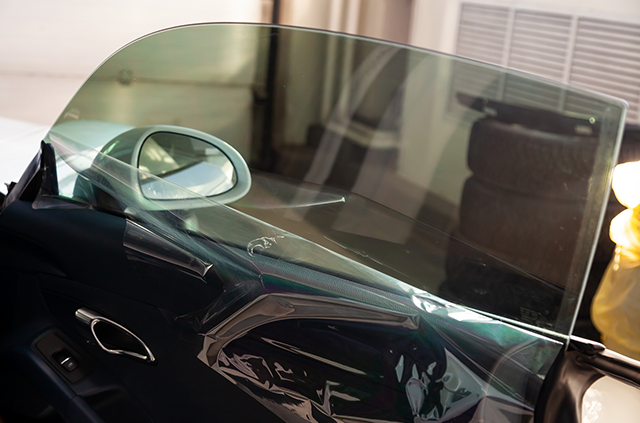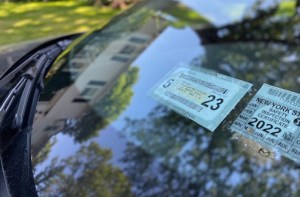You may not have realized it, but your car windows are most likely tinted — just about all cars roll off the assembly line with glass featuring some level of tint. Tinting has several benefits, but darker windows also create safety hazards. Because of this, window tint laws exist in every state.
There’s often a great deal of confusion over window tint regulations, primarily because they differ throughout the country. Some states allow for much darker windows than others. It’s important to brush up on these laws, especially if you’re considering adding additional tint to your car’s windows.
What Are Window Tints?
Window tints are thin, dark sheets of film applied to a car’s glass to help keep light out of the cabin. Most new cars come standard with some level of window tinting but aftermarket window tints are available as well.
Tinting serves several purposes. Most notably, it protects against the sun’s harmful UVA rays, which cause skin cancer as well as damage and fading to the vehicle’s interior. Window tints also help keep the cabin temperature cooler, cut down on glare from the sun and headlights, and provide car owners with a level of privacy and security. Some people simply like the way they look.
But with all these benefits comes one major drawback: visibility. The darkness of window tints makes them more difficult to see through, particularly at night, creating a safety hazard.
Window Tint Laws
Are window tints legal?
Laws regulating window tinting in passenger cars are found in every state. These statutes dictate how much light is able to pass through the glass, a measurement known as visible light transmission (VLT) percentage. The darker the window tint, the lower the percentage. VLT is usually checked as part of your vehicle’s annual state inspection.
The allowable VLT percentage minimum or legal window tint percentage varies from state to state, from 20% in New Mexico to 70% in New York, Rhode Island, California, Pennsylvania, Delaware, Iowa and Washington, D.C. Three states (New Hampshire, New Jersey and Vermont) don’t allow any tinting.

Window tint laws mainly focus on a car’s front side windows, although many states also have rules regarding back side and rear windows. States may allow for more tinting on back side windows, but, if so, usually require a car have dual side mirrors. Rear windows are often permitted to be darker than front side windows, as well.
Nowhere in the country are windshields allowed to be tinted except along the top of the glass pane. How far down the tinting is permitted to extend also varies by state.
Window tint laws can be complicated. For example, Michigan allows any percentage of tinting but only on the top 4 inches of the window. Some states allow tints to include metallic or mirrored elements, but many states ban such products. Further muddling the issue is the fact many states have different tinting laws for sedans than they do for trucks, minivans and SUVs.
It’s best to consult your state’s department of motor vehicles to know the window tint legal limit and what is and isn’t allowed.
Exemptions
Most states allow exemptions to window tints laws for people with medical conditions causing severe light sensitivity. Such conditions include albinism, dermatitis, dermatomyositis lupus, porphyria and drug photosensitivity, among others. If you require a window tint medical exemption, you can apply for one through your state’s department of motor vehicles.
Are Window Tint Laws Applicable if You’re Traveling Through Another State?
When in another state, you’re subject to that state’s laws, including those dictating window tinting. Some states provide exemptions to their tint laws to those just passing through, but others do not. In the latter case, you could be subject to a citation if your windows are too dark. That said, if you explain that you’re only visiting and your windows are in compliance in your home state, you may be able to get off without a ticket.
Have a question or comment about window tints? Share it in the comments below!
This article has been updated and republished from a previous version.
75 Thoughts on “Everything You Need to Know About Window Tint Laws”
Leave A Comment
Comments are subject to moderation and may or may not be published at the editor’s discretion. Only comments that are relevant to the article and add value to the Your AAA community will be considered. Comments may be edited for clarity and length.














I couldn’t read all the comments, but the one thing that stands out for me, is the ability to hide behind the dark tinted windows. If a child or person is abducted, no one can can tell. Police cannot see into the interior of the car, so any kind of criminal activity is hidden from view, including human trafficking. I think dark windows should be abolished.
It doesn’t matter what the laws are for window tint because at least in Connecticut nothing seems to be done about it. I have seen more and more cars now with their windshield tinted so you can pass all the laws you want, but if they’re not enforced, it means absolutely nothing
I agree with Bob, In NYC, you can see a vehicle that has completely DARK tinted and they drive by the Police without care and the Police Does Nothing.
Good to know. I am shocked by the leniency of many states. I fully get the safety concerns with windows overly tainted. I wouldn’t want to be a cop walking up to a car where it is difficult to make out who or what is in the car. I would also like to know the laws around noise from cars. I live on a somewhat busy street that has become a cut through street because of Wayz and Google maps. The motorcycles and cars with very loud (I’m sure adjusted mufflers are an incredible annoyance all times of the day. With windows closed I am often startled or awakened by the loud engines. I would say most people comply with the sound ordinances, but a good (and it seems more and more) percentage ride by with abandon. In the 25 years I’ve lived here, I’ve never seen anyone stopped for the noise. I know police for many reasons are reluctant to stop people for car violations of this sort, but it has really created a problem to the point me and a few of are neighbors are moving. There seems to be a feeling of lawlessness around car noise in our area.
I know in MA, as well as many other states, the exhaust is not supposed to exceed 80 decibels. I know this because I called the police many times for a car in my neighborhood that left his house almost every night between 12 + 2 am, and I’m 2 houses down from the corner he stops at and then turns and accelerates a standard shift sports car through 2 or 3 gears, (on a 25 MPH street on top of the excessively loud exhaust), and I had to look it up to be able to bring it to the officers attention! They finally told him he needs to drive slow enough that his exhaust noise does not reach that level, or he would be ticketed $200 for every call! The part that annoyed me most is that it’s not that loud when he drove slowly, but he just had to be COOL and make a lot of noise so everyone would hear him! Fortunately, he moved a few months ago! Good Luck!
These tints should not be sold, period! Naturally, they don’t care because they are making money. Should be outlawed
Tinted windows should be illegal. Drivers, and even passengers, should have clear visibility in order to communicate, when needed, to one another and to pedestrians; especially at pedestrian crosswalks and 4-way stop sign intersections.
As a former Officer you do not have to follow other state laws about window tinting. They cannot enforce equipment violation on your vehicle if your state does not allows it. As long as you don’t have plates from that state on your vehicle they can not even stop you for it.
There are states that only issue 1 plate. Most of the South East, Pennsylvania, and Michigan for example.
What is the tint law for Nyc
While I support the police – why should their windows be tinted if a citizen’s window cannot? Safety is cited- but ambushing of police officers is very rare. We should not have separate laws.
Agreed. If our taxes are paying for cops salaries, vehicles, weapons, pensions, and lawsuits, we have a right to see what’s going on inside a police cruiser.
Anybody know about MA laws? In my city all the police cars the windows are tinted so dark you can’t see who’s driving
I hate tinted windows and avoid them like the plague. Why? Because I can’t see out of them!
Everyone in NY is running around with tint on their main windshield…. they never get stopped
Put all windows half way down as a courtesy to the officer if you are being pulled over and you have tint. They appreciate it. The resulting stop will usually have a different outcome.
In NY I believe that commercial vehicles are aloud to have windows tinted. Can anyone confirm?
Well the story I heard about the NY law was that it began way upstate (possibly Buffalo or at least that far upstate) because a police officer’s wife was concerned that people with nefarious desires might be able to hide weapon(s) when her husband would be approaching a stopped vehicle. With my eyesight, night driving became much easier with the side and rear window tinting that greatly reduced eye strain in one vehicle decades ago.
What is the degree of tinting for Ct ??
Article information stating that NJ does not allow any tinting is incorrect. Check the MV regulations: Non-OEM tinting is not allowed on the windshield or driver and passenger side windows. It is allowed on rear side and back windows, with limitations.
As someone who is short, I wish there was a way that windshield and driver side windows could be tinted at least halfway down (or photo-sensitive) to reduce dangerous sunrise/sunset glare problems!! Ciders are never low enough!
I remember when I first moved to Tucson, I got a ticket for tinted windows. When I went to court, there were five others there with the same ticket by the same statie. Bottom line, they were having a training day on “tinted windows” because they had recently had a shooting from the back seat because the officer couldn’t see in.
I don’t understand how I see many NY vehicles w/the blackest of tints…where are they going for inspection. These tints are so black that you can not even identify if theres a driver!!
No tint is legal in NY. A factory window will test at about 75% VLT so any added tint will render the window illegal.
Next time, be a cop. Then you can do whatever you want.
For NY: We had the tint done after we bought the car by a company recommended by the dealer. We had it for security, especially at night. Last year the dealer told us we had to remove the tint or the car would not pass inspection. We removed it.
I thought police departments also had a stake in being able to view the driver and others in a car. There was a time some years ago it became a big issue in NYC, raised by the cops.
I bought a used car from someone and they purchased it from out of state. The tint that is on this car was after market and not put on very professionally. The side passenger window is wavy and the back window is hard to see out at night. The tint is also purple which I’ve never seen before. Seeing as I have trouble seeing out, would my insurance cover replacement of the windows??
Hi Gail, thanks for reaching out. You’ll need to consult your insurance company for details on the policies of your coverage.
If the tint is wavy, then it would be very easy for either a tint shop or probably any body shop to remove it. Shouldn’t cost much.
What is the law in MA?
I purchased my van in Nevada & now live in Massachusetts. When I drove through the inspection station the guy told me to go to another station on a nice day & have the windows rolled down & it worked.
I recently purchased a pre-owned vehicle in New Jersey. The windows were tinted. I paid someone to remove the tint. Why was the NJ dealer allowed to sell the vehicle if NJ doesn’t allow tinting of any kind?
Being the cynic that I am, it seems to me that most heavily tinted cars are that way because the owners don’t want the rest of us, especially police, to see what’s inside. Also, tinting is dangerous to me as a driver because it blocks me from knowing if the people in the other car can see me.
I think the same thing. Unless there is a real medical reason, I think the max tint allowed shouldn’t be more than 50%. I think anyone with darker windows is hiding something, as one commenter said, nefarious.
In my area I have seen black cars with just about black windows. To my surprise the county sheriff was driving one. I asked the city police if those black windows were against the law. They said yes but those cars were for undercover police so they wouldn’t be recognized.
Umm. If they’re the only ones allowed to be driving with black windows, won’t that make them *more* recognizable???
New York residents who want to evade tinting laws have an easy way to do so. They register their cars in other states. Though contrary to sec. 250 of the NYS DMV rules, New York’s local and state police rarely enforce this. In addition to losing many $ millions, this is yet another reason to begin to do so.
What is the window tinting law for S.C.?
Biggest reason drivers have increased their tinting recently? So they can use their cell phones undetected.
No aftermarket, ‘too dark to see who is behind them), tints should be allowed in any State, on front door windows of vehicles. If they are present, strong, meaningful fines should be levied, and if not removed (proof required) within 30 days, registrations on the vehicle(s), not renewed unless they pass a DMV inspection proving they have been removed. Who, including law enforcement people, thinks anyone should be ‘forced’ to approach a vehicle with visually impenetrable window tinting, for any reason, and possibly face a gun blast or other hostile action from the (invisible) person behind such a window?!
Totally agree
oh please the NYC PD is barely permitted to do their real jobs. The woke crowd would be tying up the streets with more protests if the police gave out tickets. Criminals have more rights here and there are Plenty of inspectors willing to look the other way on almost every illegal car issue.
So true, they stop a car and the whole neighborhood shows up to pelt them with frozen water bottles….
Rhode Island: Tint Laws, Driver and passenger windows are only allowed what the manufacturer installs as original Equipment low E glass. If it can be removed it is not allowed. (from the state inspection handbook) so it’s left up to the inspection station to police it! Most don’t want to alienate their customer, so they ignore it. So think of the officer who stops a vehicle at night on RT 95 and can’t see what’s going on inside, talk about dangerous!
I live in RI and see lots of cars, presumably driven by younger persons, with dark tint on all windows (sometimes, even the windshield). I have never heard if anyone being forced to remove their aftermarket tint. I guess inspection garages, and even many police, don’t enforce the laws, or, selectively enforce them. Personally, I think the majority of dark tint vehicles are suspect, as in they’re trying to hide something (puff-puff). Plus, there’s the safety issue of poor night visibility.
This was the case until recently. Now stations are required to take photographs of the front window to show no tint
Dear AAA, i bought a new car & requested no window tint, but they said the windows are factory-tinted & that’s the way the car is made. My question: is there any way i can remove the window tint. Thank you.
Hi Michele, thanks for the question. Here’s an answer from our Car Doctor John Paul: Factory tint is made into the glass. Only add-on aftermarket tint can be removed. Most factory tint is quite translucent on the front windows a bit darker on the rear windows if it is an SUV or van. The windshield if tinted at all is just the top couple of inches.
Unless the law has changed, RI inspection rules are NO aftermarket tinting allowed.
I have twice been forced to remove professionally install tinting. Both cars came from Fla and were not ‘excessively’ tinted (blacked out).
I also live in RI and I see heavily tinted glass all the time. Let’s face it; laws are not uniformly enforced. How many times have you seen luxury cars with one license plate?
Hi there! I also live in Rhode Island, few years ago i had my car windows tinted, the guys doing did not tell me anything about laws allowing it or not , well, needless to say, I was stopped and forced to remove it. after that I saw a lot of cars with tinted windows even darker than mine. Not fair!!! why do they even allow these window tinting places to even offer it? I guess the cops are not doing their job..
There are states that only issue 1 plate. Most of the South East, Pennsylvania, and Michigan for example.
I live in NJ, and see cars with fully-tinted windows, including rear window and sometimes windshields all the time. Down the street from me is a Auto Window tinting company that performs that service, mostly on upscale vehicles. Police do nothing, but in the present political situation I understand why. Enforcement would also be tantamount to shoveling sand against the tide. Bad situation, no hope in sight…
This is where the local govt sees that a law in ineffective and remove or delete. This is the same with transport or carry gun laws. You can be completely legal in your home state, cross a border and you are subject to incarceration. These laws should be standardized.
I have a large chip in my windshield from driving through a construction site- should I have it fixed?
Hi Patricia, thanks for the question. Yes, you should always repair a damaged windshield as soon as possible. You can find more info here:
Wouldn’t it have been a good idea to post a link to the IWFA website https://iwfa.com/state-law-charts/ with the current list for every state?
Doesn’t work for me.
Doesn’t download for me either.
Go to https://iwfa.com/ Then there is a link to laws by state.
So if I buy a car in Nevada and move to a state with a no tint law do I have to have all the tint removed?
Yes, you need to obey the laws of the state your car is registered in. You should be able to drive thru the state without an issue though.
I once bought a car from a company I won’t name…Ford….that had factory tinted windows. The first year I went for an inspection sticker in my state (MA) I couldn’t get one because the tint was too dark and therefor illegal. I had to pay to have it removed, the dealer I bought the car from who I won’t name….Ford dealer….wouldn’t do it without charging me. I took it elsewhere.
Well, first off, it was dealer applied. Most EVERY SUV (outside of base models) have tinted rear passenger, cargo and tailgate door windows tinted. This is NOT a coating that can be removed, it IS the glass itself. Any film type tinting is generally after market applied, weather it be by your dealer or a business that provides that service. Just my knowlege on the subject.
Try another inspection place, I live in Ma also. I have them check mine before I give them my money and do anything else first. I’ve had legal tint fail to a meter. I deemed the meter to be wrong. I went to another place and it wasn’t a problem. Same with factory tinted tail lights. If it’s legal and you know it is. Tell them to pound sand and go somewhere else.
It is all about the money. They pulled you over because they know that it would be difficult to come back to court to fight it.
A police officer/safety officer once told me that he was against most (but not all, e.g., top of front windshields) tinting in that a child could be strapped into a rear seat, forgotten about, and suffocating in a very hot car, or someone could be abducted and restrained and pleading for help but never seen by a passerby. Just two examples of public safety concerns, and there are several more.
Sadly, a person could be in the back of an SUV or a van with no rear windows and you couldn’t see in it either.
I agree with the police officer/safety officer.
I drive down Cranston St in Providence daily. There are lots of cars with windshields that are fully tinted. Evidently the drivers must think they look cool and can’t be identified. I wonder how they get away with this.
THIS LAW IS NOT ENFORCED IN RHODE ISLAND
Mind your on businesses
It is everyone’s business. That is why there are laws.
It’s everyone’s business when you can’t see out the sides of your car at night to avoid an accident